Sielanka estate, Bydgoszcz
Sielanka estate
Sielanka osiedle | |
|---|---|
 View of Asnyka Street | |
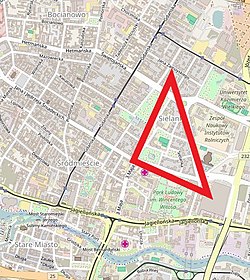 Estate territory on a map | |
| Coordinates: 53°07′41″N 18°00′49″E / 53.12806°N 18.01361°E | |
| City | Bydgoszcz, |
| Founded | 1912 |
| Founded by | Heinrich Metzger |
| Area | |
| • Total | 10.5 ha (25.9 acres) |
Sielanka estate is a housing district developed in the 1910s in the heart of downtown city Bydgoszcz, Poland. Its completion spans almost 25 years, across the political changes of the period (from the Prussian occupation to the re-creation of the Polish state). It was created in the spirit of garden city spirit from the beginning of the 20th century and refers to eclectic forms. In addition, there are many form of modernist villas, which were fashionable in the interwar period.[1]
Location[]
Sielanka is part of the downtown (Polish: Śródmieście) district of Bydgoszcz. The estate area is roughly triangle shaped, delimited by the following streets:[2]
The naming Sielanka means Idyll in Polish.
History[]
Genesis[]
Garden city movement was embodied by Ebenezer Howard, as this urban trends took off in the second half of the 19th century. The concept of garden city assumed the construction of urban bodies located around a kernel harbouring a public recreational green area, with rings of housing estates made of small plots of single-family houses, outer rings hosting public utility buildings and further out production plants. Howard's idea was especially described in his book Garden Cities of To-morrow published in 1902. Though the first garden city was located in England (Letchworth-1903), soon other instances appeared in Poland: Ząbki near Warsaw (1912), Podkowa Leśna (1925) or Gdynia (1925).[3]
At the beginning of the 20th century, the commune of then Bromberg had a vast area completely undeveloped, between Braesicke-Schiller straße (Staszica and Paderewskiego st.), Fröner straße (Markwarta st.) and Hohenzollern straße (Ossolińskich Av.).
Despite the decision in 1903 to erect the complex of the Institutes of Agriculture in the northern part, the district remained by and large bare from construction. To fill this gap, the municipal authorities asked in 1912, urban engineer Josef Stübben to develop a layout concept of this sector.[4]
Stübben (1845-1936) was a German architect educated at the Berlin Building Academy who had worked at the Technical Council of the Prussian Ministry of Finance (1904-1920) and had chaired the Poznań expansion commission. At the time, he was a recognized urban developper and devised many plans for important cities such as Aachen, Düsseldorf, Cologne, Luxembourg City, Madrid, Rostock, Warsaw. Joseph Stübben won the first prize in the international competition for the urban planning of the greater Vienna. In Prussian Poland, he also works in Poznań, Głogów and Wałbrzych.[2]
His sketch, delivered in December 1912, became the blue print for the project drawn up by Heinrich Metzger, the Bromberg city construction adviser, seconded by engineer Bernhard Hirsch. Following the garden city principles, the scheme forecasted to bear a green square at its centre and at each corner of the triangular area. Although the core plaza still exists at Turwid square, only one out of three others was achieved (today's Leszek the White square).
Practically, Metzger and Hirsch worked on the parceling of the land, making sure of the size of each of the plots, of the regular width of the front gardens, prohibiting the building of any workshops in the backrooms of the villas, dramatically limiting commercial and manufacturing activities within properties. Eventually, around 50 plots were laid down and approved for house construction.
Period before WWI[]
In the first Prussian documents, the area was called Gartenstadt (English: garden city): the name Eigenheimviertel (English: Home district) was also used to describe the entire domain. Once the building phase started, the first specific names appear to designate the places:[5]

- Eigenheimplatz, renamed Mackensenplatz (today's Turwid square, Sielanka and Wyspiańskiego streets);
- Eigenheimstrasse A, later Hindenburgstrasse (today's Kopernika street);
- Eigenheimstrasse B (today's Asnyka street).
In 1914, the city office began to allocate plots to owners by way of private selling. The first houses were erected on parcels located on both sides of Turwid square at 4,6,8 Wyspiańskiego street and 14 Sielanka street. Another house was also built , albeit with a different interior layout, at 5 Kopernika street.
The features of these villas century were characterized by complicated plans, with numerous turrets, bay windows and intricate roof structures. They generally refer to neoclassical and neo-baroque style, as part of the historicizing period. At the outset of WWI, only 5 villas have been achieved.[6]
Construction during interwar period[]
After the end of WWI, there was a ten-year stagnation period associated with the political situation (re-birth of the Polish state) and the low economic activity. The resuming of construction traffic in this part of the downtown district (and others) is inextricably linked with the 29 April 1925 Act on the expansion of cities, which imposed on municipalities an obligation to improve the housing situation and created preferential financial conditions for the development of villa-type accommodation.[3]

New constructions lifted off in 1927, in particular with the support of architect engineer Bogdan Raczkowski who had been appointed in December 1922, as deputy chairman of the urban management committee. Strict regulations were issued for the future buildings, among others:
- villas could be equipped with a maximum of two full floors (i.e. ground floor and first floor) and a Mansard roof;
- would-be flats in the basement should have a special sanction from the Municipal Office;
- these flats may not be used for renting purposes;
- stable facilities were not allowed.
Such constraints allowed buildings to maintain their character, even though the City Development Committee was inclined, when possible, to promote the construction of multi-apartment villas.
During this period, 18 new villas were built from 1927 to 1930, 17 new ones from 1930 to 1933 and 4 before the outbreak of WWII.[3]
Main streets and places[]
Markwarta street[]
Named after Ryszard Markwart (1868-1906), a Polish priest who was a nationalist activist and head of Bromberg parish from 1899 till his death, the street delineates the southern border of Sielanka estate. Most of its northern side features villas dating back to this project.
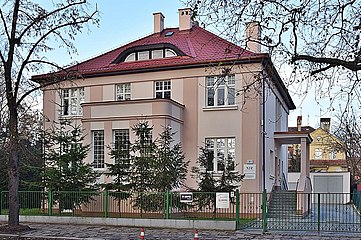
Villa at No.7 by Józef Grodzki (1927-1928)
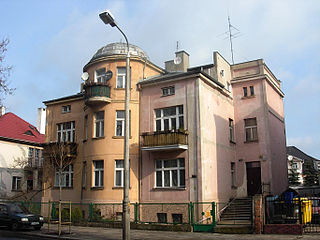
Villa at No.9 by Józef Grodzki (1927-1929)

Wacław Millner villa at No.11, by Jan Kossowski (1937-1938)
Ossoliński avenue[]
Laid out in the early 1900s, it marks out the eastern limit of the Sielanka district. To the east, most of the plots belong to the buildings of the Institute of Agriculture, established in 1903-1906. A significant share of the western frontages display functionalist features or Polish National style.
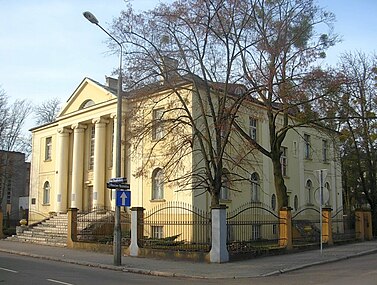
Villa at No.7, by Bronisław Jankowski (1927-1929)
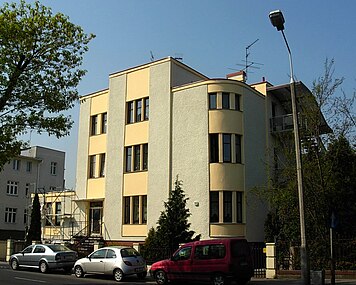
Villa at No.11 by Henryk Misterek (1932-1933)

Villa at No.21 by Bolesław Polakiewicz (1932-1933)
Józef Weyssenhoff Square[]
The plaza is located at the nothern tip of Sielanka area. Due to his earlier development, only the southern frontages are related to the project, the others having been erected at the beginning of the 20th century.

Building at No.2, by Bogdan Raczkowski (1927)

Tenement at No.4 by Eugeniusz Wellman (1933)
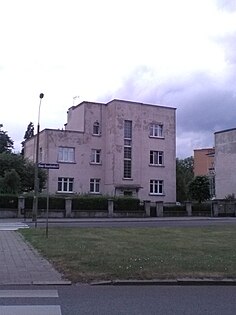
Villa at No.6 by Konstanty Dzielinski (1934-1935)
Sielanka street[]
Sielanka Street is a small and twisty road, laid in the mid-1910s: it displays a series of villas, each of which is unique in its architectural concept.

View of Sielanka street

Villa at No.3 by Bronisław Jankowski (1934-1935)
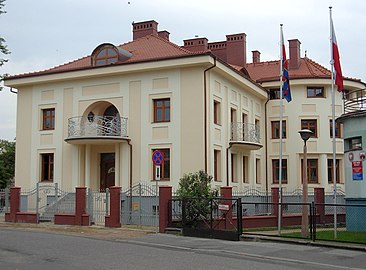
Villa at No.10 by Bronisław Jankowski (1927)
Kopernika street[]
Short street where several villas are registered on the Kuyavian-Pomeranian Voivodeship Heritage List. The street is named for Nicolaus Copernicus (1473 – 1543).
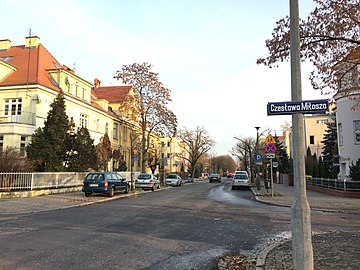
View of Kopernika street
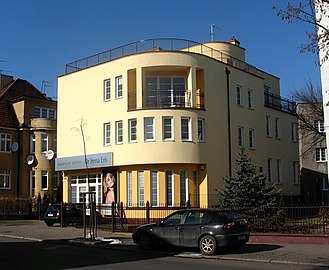
Villa at No.7a by Bolesław Polakiewicz (1933-1933)
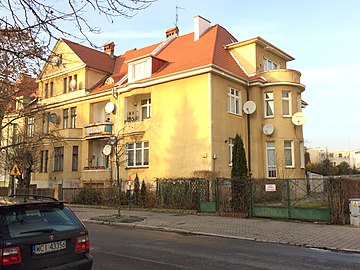
Villa at No.5 by Rudolf Kern (1914-1916)
Adama Asnyka street[]
Bogdan Raczkowski villa at No.1[]
1932-1933,[7] by Bogdan Raczkowski[3]
Early Modernism
Located at the corner with Kopernika Street, the architect Bogdan Raczkowski designed it to be his own house.[6] Later on a merchant, Włodzimierz Raczkowski, took ownership of the villa.[8]
Part of the garden is dedicated to a tennis court.[9]
Villa at No.1A[]
1939, by Bogdan Raczkowski[3]
Modernism
One of the last house built as part of the Sielanka estate project, before the start of WII.
Villa at No.2[]
1933-1934,[7] by Bolesław Polakiewicz[3]
Modernism
One can notice the distinctive stained glass panels highlighting the staircase.
Villa at No.3[]
1933-1934,[7] by Bolesław Polakiewicz[3]
Modernism
First owner was Klemens Stark, a merchant.[10]
Villa at No.4[]
1932-1933,[7] by Witold Eysymont[3]
Modernism
Stanisław Dziurzynski, an engineer, was the commissioner of this house in the beginning of the 1930s.[10]
Villa at No.5[]
1927-1931,[7] by Bronisław Jankowski[3]
Polish National Style
The owner of the villa was Paweł Aleksandrowicz, a reserve colonel.[11] Living initially at 4 Śniadeckich Street, he moved there in 1936-1937.[10]
Villa at No.6[]
1933-1934,[7] by Jan Kossowski[3]
The investor was a doctor, Stefan Gaszyński. Before the construction was completed, the house was bought by lawyer Stanisław Kaszyński.[9] He had his office at 17 Gdańska Street.[10]
The villa is decorated with a glazed, rounded bay window, terraces and balconies recalling ship captain's bridges, with by bent metal balustrades. Large windows on the ground floor connect the interior with the garden greenery.
Villa at No.7[]
1927-1928,[7] by Bronisław Jankowski[3]
Polish National Style
The oldest house in Asnyka street, it was originally commissioned by Brigadier general, Aleksander Ehrbar,[11] who commanded the 16th Uhlan regiment.[12] Before moving there in 1933, he was living at 7 Reja Street.[11]
Stanisława Wyspiańskiego Street[]
Tadeusz Mieczkowski villa at No.2[]
1927-28,[7] by Tadeusz Mieczkowski[3]
Early Modernism and Polish National Style
Tadeusz Mieczkowski, an engineer, designed the villa and lived there[13] till the outbreak of the Second World War.[10]
Villa at No.4[]
1914-1915,[7] by Gustaw Burschat[3]
Late Art Nouveau and Polish National Style
Leopold Siedlecki is the first registered owner in the early 1920s, although the house is part of the batch of the first realizations during the Prussian period.[14] The style reflects this, exhibiting Art Nouveau elements, in particular around the portal.
Kurtz Seydler villa at No.6[]
1914,[7] by Rudolf Kern[3]
Late Art Nouveau and Polish National Style
Kurtz Seydler ran a wallpaper selling business downtown, at Dantziger Straße 158 (today's 24 Gdańska Street).[15] One can notice the grand portal flanked by columns, topped by a wrought iron-motifs balcony, the two rosettes surrounded by lesene and the oeil-de-boeuf on the top of the facade.
Villa at No.8[]
1914-1917,[7] by Theodor Patzwald[3]
Polish National Style
Completed just before the start of the First World War, Paweł Schönerstädt (or Schoenerstaedt), a factory manager, was its first owner.[14] Here, the portal is brought up to a higher level of decoration close to Neo-baroque style, including a large triangular pediment supported by four marble Corinthian order columns. Furthermore, the entrance door is heavily adorned with floral motifs and another couple of pink columns. The rest of the facade is highlighted with pilasters, a crowning frieze and a half-moon oeil-de-boeuf.
Kazimizerz Panek villa at No.10[]
1928-1930,[7] by Józef Grodzki[3]
Early Modernism and Polish National Style
Dr. Kazimizerz Panek was a Professor at the university.[8] His widow survived him in the house till WWII. The villa is located at the corner with Sielanka Street. The main elevation on Wyspiańskiego street displays a nice transom light door highlighted by pilasters and wall lesenes. [10]
Jana Kasprowicza Street[]
Villa at No.2[]
1927-29,[7] by Bronisław Jankowski[3]
Polish National Style
First registered owner was an engineer, Teodor Krieger.[8] Today, the house harbors the seat of the Chamber of Commerce "Wodociągi Polskie" (English: Polish Waterworks), the only economic self-government organization in the water and sewage sector in Poland, established in September 1992.[16]
Villa at No.4[]
1933-1934,[7] by Bolesław Polakiewicz[3]
The first known landlord was Włodzimierz Hordyński, the director of the bank Spółdzielcza Kasa Oszczędnościowo-Kredytowa (SKOK), which seat was at 1 Hermana Frankego street (present day Stary Port Street).[10]
Władysława Reymonta street[]
This short street path is located between the Leszka Białego Square on the south and Bydgoszcz University building Copernicanum on the north.
Czesława Miłosza street[]
Initially named "Wilsona street" in reference to the American President Woodrow Wilson, this tiny path is bordered on its western flank by the Copernicanum and the Kopernika Square, while its eastern side stems from the Turwid Square and crosses Sielanka street to end at Kopernika street.
Squares[]
Marian Turwid Square[]
The original 0.4 hectares (0.99 acres) square design has been modified in 1925, by engineer Marian Guntzl, who created a new garden layout,[2] in the same way as he will design a few years later the city Botanic Garden.[17] It has been named in reference to Marian Turwid (1905-1987), a Polish writer, painter and cultural activist in Bydgoszcz.[18]
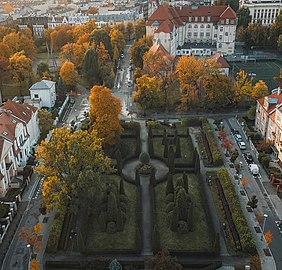
Bird eye view square
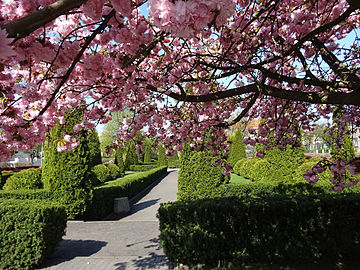
Plaza in springtime
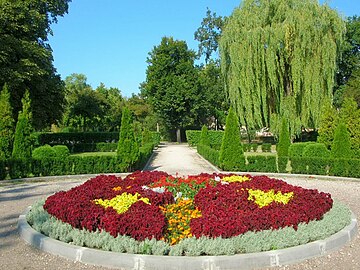
Flowers in summer
Leszka Białego Square[]
Sielanka project included this square as a property of the Province of Posen (German: Provinz Posen) and not owned by the municipality. After the rebirth of Poland in 1918, the area was declared to be constructed, but no project was ever completed. In the 1960s, a memorial has been built up to celebrate the Millennium of the Polish State (Polish: Pomnik Tysiąclecia Państwa Polskiego). Designed by Polish artist Stanislaw Lejkowski, it was unveiled on July 22, 1967.[19] However, the entire scheme was never achieved: the nest in the tripod was supposed to be crowned with the Piast eagle, which was considered by the communist authorities to be too similar to the symbols used during WWII by the Polish Armed Forces in the West.[20] In 2011, the city had even projects to demolish it, but it turned out to be too expensive.[21]
The site has been given the name Lieutenant Leszek Biały in November 2013.[22] Leszek Biały was a hero of the Home Army during the Second World War. His father Ludwik lived at 1 Sielanka Street.[23] Under the code name Jakub, he was arrested in February 1945 by members of soviet controlled Ministry of Public Security and was murdered during interrogations on March 3, 1945. In October 1956, his remains were discovered in the basement of the UB building then located at 4 Markwarta street.[24] A renovated stone memorial to honor Leszek Biały and his heroic comrades has been unveiled in 2013.[25]

The square from Markwarta street
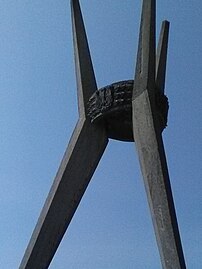
The unachieved monument to the Millennium of the Polish State
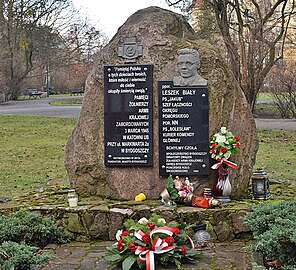
The stone memorial
Mikołaja Kopernika Square[]
Kopernika Square is a green area landscaped in 1973. Its statuary includes a metal sculpture of a female figure by Maria Chudoba-Wiśniewska, a mid-20th century sculptor of Poznań. The sculpture weighs 864 kg and is 4,57m tall. The sculpture was erected during the National Open Air Sculpture Festival (Ogólnopolski Plener Rzeźbiarski) which took place from August to September, 1973. Round shaped stones can be found on the grass, positioned on ellipse rings surrounding the statue: they represent the planets of the solar system in orbit, including the Sun and the Moon.[26]

Statue in Kopernika Square
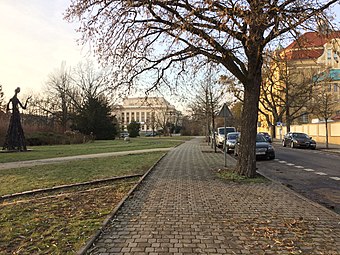
Ellipse rings with round stones on Kopernika Square
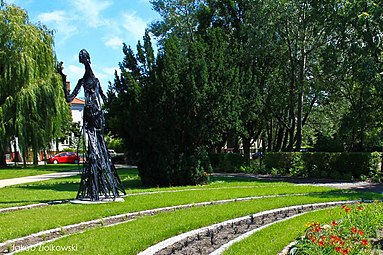
Kopernika Square in summer
See also[]
| Wikimedia Commons has media related to Sielanka estate, Bydgoszcz. |
- Bydgoszcz
- Bydgoszcz Architects (1850-1970s)
- Copernicanum building in Bydgoszcz
- Institutes of Agriculture of Bydgoszcz
- Saint Vincent de Paul Basilica
References[]
- ^ "Sielanka w Bydgoszczy". polskieszlaki.pl. PolskieSzlaki. 2021. Retrieved 2 March 2021.
- ^ Jump up to: a b c Ziółkowski, Jakub (12 July 2011). "Miasto-Ogród. Osiedle Sielanka w Bydgoszczy". bydgoszcz.naszemiasto.pl. Polska Press Sp. z o. o. Retrieved 2 March 2021.
- ^ Jump up to: a b c d e f g h i j k l m n o p q r Derkowska-Kostkowska, Bogna (1999). o zalozeniu Sielanki-bydgoskiego miasta ogrodu. Materialy do Dziejów Kultury i Sztuki Bydgoszczy i Regionu. zeszyt 4 (in Polish). Bydgoszcz: Pracownia Dokumentacji i Popularyzacji Zabytków Wojewódzkiego Osrodka Kultury w Bydgoszczy. pp. 72–85.
- ^ "Sielanka". bydgoszcz.naszemiasto.pl. Bydgoskie Centrum Informacji. 2018. Retrieved 2 March 2021.
- ^ Plan der stadt Bromberg mit Vororten [Map of the city of Bromberg with suburbs] (Map). 1:10000 (in German). Bydgoszcz: A. Dittmann. 1914.
- ^ Jump up to: a b Wysocka Agnieszka, Daria Bręczewska-Kulesza (2003). Wille na Sielance. Kronika Bydgoska Zeszyt 25 (in Polish). Bydgoszcz: Towarzystwo Miłosnikow Miasta Bydgoszczy - Bydgoskie Towarzystwo Naukowe. p. 57.
- ^ Jump up to: a b c d e f g h i j k l m n Prezidenta Miasta Bydgoszczy (7 August 2015). Zarządzenie Nr439/2015. Bromberg: Prezidenta Miasta Bydgoszczy. pp. 5, 33, 88.
- ^ Jump up to: a b c Kziążka adresowa Miasta Bydgoszczy 1933. Bydgoszcz: Władysław Weber. 1933. pp. 36, 92, 97, 225, 251.
- ^ Jump up to: a b Spacer Modernizm po Bydgoszczy. Bydgoskie Centrum Informacji. 2018. pp. 1–2.
- ^ Jump up to: a b c d e f g Kziążka adresowa Miasta Bydgoszczy 1936-37. Bydgoszcz: Władysław Weber. 1936. pp. 3, 222, 319, 389, 422, 501, 503.
- ^ Jump up to: a b c Kziążka adresowa Miasta Bydgoszczy 1928. Bydgoszcz: Władysław Weber. 1928. pp. 3, 7, 14.
- ^ Dziennik Personalny. N.89. Warszawa: Ministerstwo Spraw Wojskowych. 4 September 1925. p. 484.
- ^ Kziążka adresowa Miasta Bydgoszczy 1929. Bydgoszcz: Władysław Weber. 1929. p. 227.
- ^ Jump up to: a b Kziążka adresowa Miasta Bydgoszczy 1922. Bydgoszcz: Władysław Weber. 1922. pp. 128, 586.
- ^ Adressbuch nebst Allgemeinem Geschäfts-Anzeiger von Bromberg mit Vororten für das Jahr 1917 : auf Grund amtlicher und privater Unterlagen. Bromberg: A.Dittmann. 1917. p. 267.
- ^ "Kim jestesmy". igwp.org.pl. Izba Gospodarcza "Wodociągi Polskie". 2021. Retrieved 1 March 2021.
- ^ "Sielanka". visitbydgoszcz.pl. Bydgoskie Centrum Informacji. 2018. Retrieved 21 February 2021.
- ^ Trybuna Robotnicza, No. 4 (4350). Katowice: Śląskie Wydawnictwo Prasowe RSW "Prasa". 7 January 1958. p. 2.
- ^ "Pomnik Tysiąclecia Państwa Polskiego". visitbydgoszcz.pl. Bydgoskie Centrum Informacji. 2016. Retrieved 19 November 2017.
- ^ Mąka, Wojciech (12 January 2021). "Pomnik na skwerze Leszka Białego w Bydgoszczy ogrodzony. Są kontrowersje, konflikt trwa już wiele lat". bydgoszcz.naszemiasto.pl. Polska Press Sp. z o. o. Retrieved 2 March 2021.
- ^ Idczak, Katarzyna (2 May 2011). "Co ze skwerem na Sielance?". expressbydgoski.pl. expressbydgoski. Retrieved 19 November 2017.
- ^ kd (25 November 2013). "Tablica upamiętniająca ppor. Leszka Białego wróciła na skwer". bydgoszcz24.pl. bydgoszcz24. Retrieved 7 January 2018.
- ^ Borakiewicz, Wojciech (29 April 2020). "Zburzona willa przy Sielance ma zostać w pełni zrekonstruowana. Jest problem: Nie było zgody na całkowitą rozbiórkę". bydgoszcz.wyborcza.pl. Gazeta Wyborcza. Retrieved 2 March 2021.
- ^ "Biały Leszek (1919 – 1945)". cmentarz.bydgoszcz.pl. cmentarz.bydgoszcz. 2016. Retrieved 26 February 2021.
- ^ "Uroczyste odsłonięcie tablicy upamiętniającej ppor. Leszka Białego". pomorska.pl. gazeta pomorska. 25 November 2013. Retrieved 6 April 2019.
- ^ Bydgoszcz Guide. Bydgoszcz: City of Bydgoszcz. July 2014. p. 111. ISBN 978-83-917786-7-8.
Bibliography[]
- (in Polish) Derkowska-Kostkowska, Bogna (1999). o zalozeniu Sielanki-bydgoskiego miasta ogrodu. Materialy do Dziejów Kultury i Sztuki Bydgoszczy i Regionu. zeszyt 4 (in Polish). Bydgoszcz: Pracownia Dokumentacji i Popularyzacji Zabytków Wojewódzkiego Osrodka Kultury w Bydgoszczy. pp. 72–85.
- (in Polish) Wysocka Agnieszka, Daria Bręczewska-Kulesza (2003). Wille na Sielance. Kronika Bydgoska Zeszyt 25 (in Polish). Bydgoszcz: Towarzystwo Miłosnikow Miasta Bydgoszczy - Bydgoskie Towarzystwo Naukowe. p. 57.
External links[]
- (in Polish) "Wodociągi Polskie" Chamber of commerce
- (in Polish) Page of Bydgoszcz University
- Streets and squares in Bydgoszcz
- Parks in Bydgoszcz












































